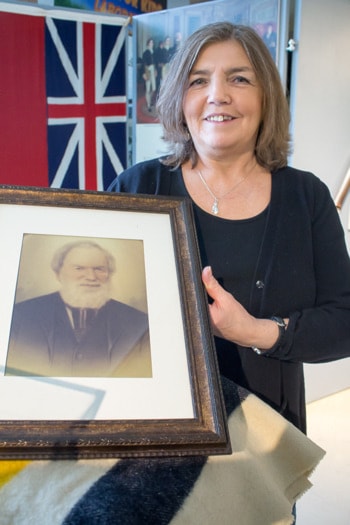The War of 1812, between the U.S. and Britain, was predominantly an eastern conflict, but a new exhibit at the Penticton Museum shows how the war affected the development of the west and continues to affect it to this day.
The War of 1812 in the West was developed by Ken Favrholdt, formerly of the Osoyoos Museum, and the exhibit is making its final stop in Penticton until March 14.
“What this exhibit shows is there was an effect here. That struggle between Britain and the U.S. back then was about claiming property and land. On this side of the country, that struggle was represented through fur trading land rights,” said Peter Ord, curator of the Penticton Museum.
And trade, continued Ord, was a key factor in the development of the Okanagan, starting with First Nations traders.
“The Okanagan has served as a transport corridor for thousands of years, first of all with First Nations traders up and down, then fur traders with the arrival of the Europeans, and then you have the cattle drives, bringing cattle all the way up to Barkerville and the Cariboo,” said Ord.
Penticton has always had a special relationship to transportation and trade, which probably reached its modern height with the arrival of the steamships on the lake and the Kettle Valley Railway.
And you can’t talk about trade in the west with talking about the Hudson’s Bay Company.
Roderick McLean was a key figure in the HBC’s history in the area, hired to manage their fort in Keremeos at a time when the company was consolidating its Canadian interests north of the new border.
“They enlisted him because he had been the best axeman on the Boundary commission. So he was already in the Similkameen area when they enlisted him,” said Karen Collins, McLean’s great-granddaughter. “This post was really important because they were trying to bring all the HBC interests into B.C., away from Fort Colville.
“Even though he was responsible for trying to gather furs and what not, really the main reason they had the post in Keremeos was to raise horses.”
McLean worked for the HBC from 1863 to 1867, when pack trains were still the main way of moving furs and other products from centre to centre and it was the responsibility of the Keremeos fort to provide the horses.
“He was very good at everything he did, but not with the books and he extended too much credit,” said Collins. That was why McLean eventually left the HBC, but not without a reputation for being a tough horseman.
“At the same time there are great stories. There is a story about one winter taking a pack train through to New Westminster, they would go up over the Hope-Princeton, he lost 25 horses because of the weather,” said Collins. McLean still managed to get the pack train through, though.
“He was known for being a really good pack man,” said Collins, who works for the HBC herself.
“I feel like I am in the family business,” she said, remembering visiting the HBC in what is now the city centre building as a child.
That building, she said, was built by Greyback Construction, the same company that just finished a $1-million renovation on the modern store in Cherry Lane Shopping Centre.
McLean was also responsible for moving the Keremeos post from its original location to the upper bench, near the site of the grist mill. He also encouraged HBC to open another post in Osoyoos.
“It was a much better location coming up and down the valley, so now you think the main entry coming into the Okanagan is in Osoyoos. Whoever controls Osoyoos controls the trade,” she said. “They always looked to have control of those important trading networks.”
The exhibit has its official opening on Feb. 1 from 2 to 4 p.m. Ord said it will be family-friendly, with activities for everyone to try.
“They can try their hand at traditional sorts of activities traders would have been involved in from making candles to making beads,” said Ord.
Then, on Feb. 18, Favrholdt will be dropping by the museum to deliver one of their Tuesday Brown Bag lunch lectures, discussing the influences of the War of 1812. He will also be doing a special session for schools that day.
